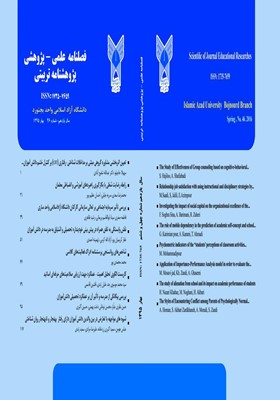شاخصهای روانسنجی پرسشنامه ادراک فعالیتهای کلاسی
محورهای موضوعی : علوم تربیتی
1 - استادیار گروه روانشناسی، واحد قوچان، دانشگاه آزاد اسلامی، قوچان، ایران.
کلید واژه: پایایی, روایی عاملی, ویژگیهای روانسنجی, ادراک فعالیتهای کلاسی,
چکیده مقاله :
هدف پژوهش حاضر، بررسی روایی عاملی و پایایی "پرسشنامه ادراک فعالیتهای کلاسی"جنتری ، گابل و ریزا(2002)است. در این راستا پرسشنامه ادراک فعالیتهای کلاسی بر روی 360 دانشجو(252 دختر و 108 پسر) که با روش نمونهگیری طبقهای از بین دانشجویان دانشگاه آزاد اسلامی واحد قوچان انتخاب شدند، اجرا شد. برای بررسی پایایی پرسشنامه از ضریب آلفای کرانباخ و برای تعیین رواییعاملی از تحلیل عاملی اکتشافی و تاییدی استفاده شد. همسو با نتایج جنتری، گابل و ریزا (2002)و کارشکی و همکاران (1388 و 1390) مطالعه حاضر نشان داد که این پرسشنامه از همسانی درونی قابل قبولی برخوردار است و ضریب آلفای کرانباخ کل آزمون 901/0 ، و در خرده آزمون های آن بین 662/0 تا 91/0 است. همچنین نتایج تحلیل عاملی تاییدی و اکتشافی مؤید آن است که ساختار پرسشنامه برارزش قابل قبولی با داده ها دارد و کلیه شاخص های نیکویی برارزش، مدل را تایید میکنند(MR=0/07 RMSEA=0/056, GFI=0/90, AGFI=0/85, CFI=0/91)). بنابراین پرسشنامه میتواند ابزار مناسبی برای ارزیابی ادراک دانشجویان از فعالیتهای کلاسی باشد.
The present study aims to investigate the factorial validity and reliability of a “students’ perceptions of classroom activities questionnaire” made by Gentry, Gable and Rizza (2002). In this regard, the students’ perceptions of classroom activities questionnaire was carried out on 360 students (252 girls and 108 boys) who were selected through stratified sampling method from among the students of the Faculty of Humanities at Islamic Azad University of Quchan. In order to assess the questionnaire reliability, Cronbach's alpha coefficient was used, and to determine the factorial validity, exploratory and confirmatory factor analysis was applied. In line with the results obtained by Gentry, Gable and Rizza (2002) and Karshky, et al. (2009, 2011), the present study showed that this questionnaire has acceptable internal consistency and Cronbach's alpha coefficient of the test is 0.901 and for the subtests, it is between 0.662 and 0.91. Also, the results of exploratory and confirmatory factor analysis indicate that the questionnaire structure has acceptable fit to the data and all the goodness of fit indices confirm the model (AGFI= 0.85, GFI= 0.90, RMSEA= 0.056, RMR= 0.07, CFI= 0.91). So, this questionnaire can be a useful tool for assessing students’ perceptions of classroom activities.


